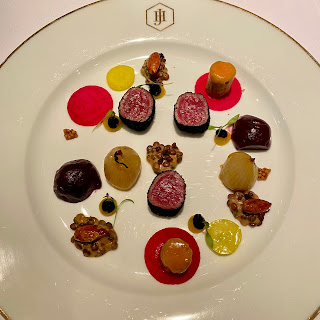Zazu - Quito, Ecuador
Landing in Quito, Ecuador, in the late hours of the night, there was no way to know what to expect; the perfect start to this group, expedition-style trip. The Mariscal Sucre International airport ended up being quite large, busy and modern compared to what I would have thought. The road, however, did not offer the same comfort for the 45 minute drive to the hotel. At 9,350ft of elevation (NYC is 35ft), driving through clouds and what seemed to be an endless dark, zig-zagging highway with only the rare light of cars traveling in the opposite direction as reference, even the most tired traveler was up for the ride. Taking in the sites of Quito the next day, everyone was a little on edge as government buildings were still protected by barricades and wrapped in barbed wire from protests just the previous week. Still, the rich history, beautiful architecture and friendly locals offering a variety of delicious yet foreign-looking street food, put the possibility of any social unrest at the back of everyone's mind. I'm all for trying new things, but I had to keep my gourmand card close, to play later that night at Zazu restaurant.
Only a 15 minute walk, but also a more convenient $5 cab ride, Zazu's warm and welcoming lights stand out in the otherwise quiet neighborhood. Just like its interior decor and style of cuisine, the entrance is sleek and contemporary. Creating clean lines with wood, glass and steel the restaurant is modern in all regards and definitely stands out as unique in the neighborhood. On the left, a dim, stylish bar & lounge with a long dark granite countertop and perfectly placed top shelf liquor. Those skipping a cocktail en lieu of wine should definitely ask to visit the Relais & Chȃteaux restaurant's 25 foot tall wine cellar. On the right, a split level dining room with a monochrome color scheme and understated modern art floating over rich textured wallpaper. The service is much warmer than the decor as the local, eager young team smile throughout the evening, proudly showing off Ecuadorian fine dining. At the pass is Ecuadorian Chef Wilson Alpala, serving contemporary Latin cuisine, using ingredients from the restaurant's own greenhouse and works directly with farmers and Galapagos-based fisherman who abide by sustainable practices. Among certain dishes that I've never seen offered before such as cazuela, prawn terrine and picanha, the stand-out item was what Ecuadorian cuisine is famously known for, guinea pig. As I contemplated the lavish version of the local delicacy out loud with the waiter a nearby Westerner insisted, "highly recommend it!". "I'll have the cuy, please!"
Amuse Bouche
Corn Soup - Sweet Corn, White Corn, Corn Bavarois, Prawn Terrine
Cuy or Guinea Pig - Confit, Peanut Ravioli, Morocho, Tomate de árbol* Demi Glace
Many locals joked that the name for guinea pig in Spanish is "cuy" because that's the noise it makes.
*Tomate de árbol is the Spanish term for the tree which bears Tamarillo, a fruit more commonly known as a tree tomato.
Many locals joked that the name for guinea pig in Spanish is "cuy" because that's the noise it makes.
*Tomate de árbol is the Spanish term for the tree which bears Tamarillo, a fruit more commonly known as a tree tomato.
Duck - Lavender, Sichuan Pepper, Coriander, Purple Potato, Grilled Melloco
Helado De Pailla - Ice cream prepared table side in traditional brass pan with liquid nitrogen
Hazelnut Crumble & Meringue
Throughout the day I had noticed several street vendors offering what looked like a thick sorbet looking paste out of a large, shallow bronze bowl. It was being served on ice cream cones, but it wasn't melting, so I couldn't make sense of it. Come dessert time, I was about to pass until I glanced and saw "ice cream prepared table side" and I thought to myself, could this be it? Lo and behold, it was, Helado de Pailla - which roughly translates to "ice cream from bowl". Made most commonly with native Ecuadorian fruits and a bit of sugar. The reason I couldn't figure out why it wasn't melting in the direct sun is because ice and sea salt keeping the bronze bowl cold were hidden underneath. In the video above Zazu takes a modern and quicker approach to the preparation using liquid nitrogen. Volume up to hear the waiter's explanation as he prepares the dish.
Zazu's commitment goes beyond that of maintaining white table cloth service and fine dining standards. Chef Alpala strongly believes that children must be taught about healthy eating practices at a young age and volunteers his time by sharing his passion and knowledge about the importance of respecting the eco systems we take from. I hope you enjoyed this piece on Zazu and the first of a few upcoming Dined There, Sipped That posts in South America. For more information on Zazu visit www.ZazuQuito.com.
From modern to seemingly fantasy, and keeping within the Relais & Chateaux family, have a look at Magdalena restaurant in Baltimore, here.







Comments
Post a Comment